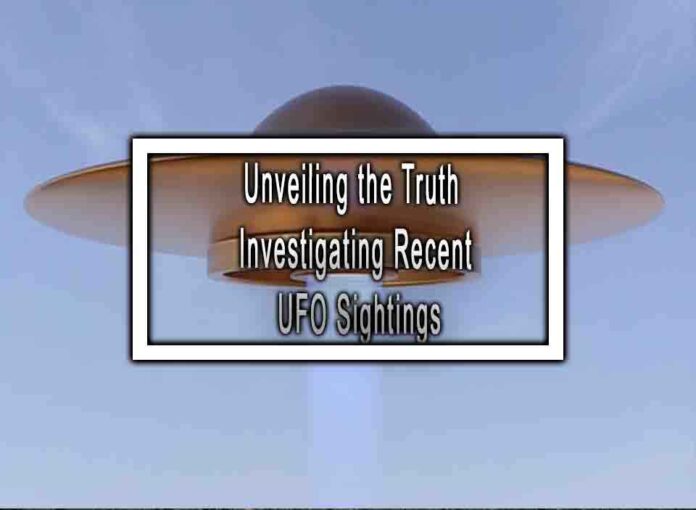Investigating recent UFO sightings involves a systematic and evidence-based approach to determine the nature of the observed phenomena. Here’s a step-by-step guide to unveiling the truth behind these sightings:
Gather Eyewitness Testimonies:
- Start by collecting detailed accounts from eyewitnesses who observed the UFOs. Document their descriptions, the date and time of the sighting, location, and any unusual behavior or characteristics of the objects.
Photographic and Video Evidence:
- Examine any available photographs and videos related to the UFO sightings. Verify the authenticity of the media and assess their quality. Consider factors like image resolution, stability, and context.
Radar and Instrumentation Data:
- If radar data or instrumentation readings are available, analyze them to corroborate the eyewitness accounts. Radar data can provide valuable information about the object’s speed, altitude, and flight path.

- If radar data or instrumentation readings are available, analyze them to corroborate the eyewitness accounts. Radar data can provide valuable information about the object’s speed, altitude, and flight path.
Consult Experts:
- Seek input from experts in relevant fields such as astronomy, aviation, meteorology, and physics. Experts can help evaluate the evidence and offer insights into possible explanations.
Natural Phenomena:
- Consider natural phenomena as potential explanations. Many UFO sightings can be attributed to meteorological events, atmospheric anomalies, celestial objects (e.g., planets or meteors), or even optical illusions.
- Man-Made Objects:
- Investigate the possibility of man-made objects, such as drones, experimental aircraft, or balloons, being responsible for the observed phenomena. This includes examining local flight regulations and military exercises.
Psychological and Perceptual Factors:
- Assess the role of psychological and perceptual factors that can influence UFO sightings. These may include misperceptions, optical illusions, mass hysteria, and cultural influences.
Data Correlation:
- Correlate multiple data sources, including eyewitness accounts, photographic evidence, and radar data, to construct a comprehensive picture of the sighting. Look for consistencies and inconsistencies in the information.
- Government and Military Involvement:
- Investigate any government or military involvement in the UFO sightings. Declassified documents or official statements may shed light on the events.
- Public Disclosure:
- Encourage public disclosure of information related to the sightings, including government reports, if applicable. Transparency in investigations can help build public trust.
Public Awareness Campaigns:
- Engage with the public and educate them about the scientific process of investigating UFO sightings. Promote critical thinking and discourage unfounded speculations.
Scientific Community Involvement:
- Encourage the involvement of the scientific community in investigating UFO sightings. Researchers can provide valuable expertise and objectivity in evaluating evidence.
Ongoing Monitoring:
- Continue monitoring the area for additional sightings or related phenomena. Frequent or recurring sightings may provide opportunities for further investigation.
Remember that the goal of investigating UFO sightings is not necessarily to confirm extraterrestrial life or advanced technology. Instead, it is to rigorously assess the available evidence and apply scientific principles to determine the most plausible explanations for the observed phenomena. While many sightings have natural or man-made explanations, some remain unexplained, highlighting the need for continued research and open-minded inquiry.











